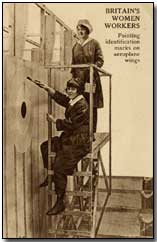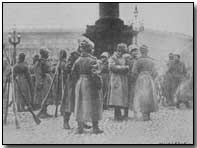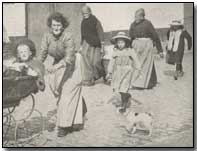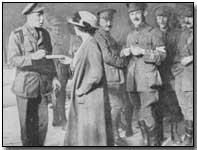Feature Articles - Women and WWI - The Woman Writer: The Problem of Ventriloquism
 We have no unified picture of what WWI was like for both men and women. While
women generally accept men's testimonials, whether personal or artistic, as
forms of universal experience even when they may vastly differ from their own,
men tend to see women's as gender specific. The formation of the literary canon
for the Great War by academic specialists in the 1960s - on the occasion of the 50th
anniversary of its beginning - focused thus on the masculine conception of war as
combat, therefore ignoring the war-related literary output of women.
We have no unified picture of what WWI was like for both men and women. While
women generally accept men's testimonials, whether personal or artistic, as
forms of universal experience even when they may vastly differ from their own,
men tend to see women's as gender specific. The formation of the literary canon
for the Great War by academic specialists in the 1960s - on the occasion of the 50th
anniversary of its beginning - focused thus on the masculine conception of war as
combat, therefore ignoring the war-related literary output of women.
Feminist scholarship first reacted to this unfair marginalisation essentially after the publication of Paul Fussell's The Great War and Modern Memory (1975), the first book to raise significant gender issues in relation to the war. This, combined with the impact of an exhibition at the Imperial War Museum on war and women, a cluster of episodes in the popular TV series Upstairs Downstairs and work by women historians using the testimony of female survivors, propelled academic work on women and WWI in a fresh direction.
The 1980s and 1990s saw a flood of publications devoted to, on the one hand, rescuing and vindicating the forgotten texts by women, and on the other hand, building a parallel canon for women's WWI literature, heavily tinged by feminism.
This bias has generated a number of contradictions still unsolved. First, feminist academic work on WWI tends to neglect pro-war, conservative women writers in an effort to maximise the impact of pacifist, feminist WWI women and to generally dissociate women from masculinist, militarist doctrines. The canon thus built gives a false impression of women's positions regarding the Great War, though the same can be said about the canonisation of male figures like Wilfred Owen. Second, the feminist project of gaining respect for WWI women writers found a very receptive female audience but not necessary one among male scholars.
So far, none has written a history of either the war or its literary and artistic output that fairly represents both sexes. The anthology Minds at War (1996) edited by David Roberts comes close to this ideal, as it is organised by topic and mixes together whatever men and women had to say about the particular issues raised by the war. Logically, more women have been selected for the section on the home front, but women's voices are represented also in sections devoted to propaganda or the armistice.
 In contrast, the recent Cambridge
Companion to the Literature of the First World War (2005, Vincent Sherry (ed.))
devotes a separate chapter to women writers - written by a woman, Claire Buck -
instead of discussing them together with men in the chapters devoted to
particular literary genres. This apartheid organisation is clearly based on the
assumption that women are a separate case that needs to be better known before
it's treated together with the men but this very notion spells out the fact that
women's experiences are not seen yet as an integral part of WWI. They're no
longer a footnote, but they're still a separate chapter.
In contrast, the recent Cambridge
Companion to the Literature of the First World War (2005, Vincent Sherry (ed.))
devotes a separate chapter to women writers - written by a woman, Claire Buck -
instead of discussing them together with men in the chapters devoted to
particular literary genres. This apartheid organisation is clearly based on the
assumption that women are a separate case that needs to be better known before
it's treated together with the men but this very notion spells out the fact that
women's experiences are not seen yet as an integral part of WWI. They're no
longer a footnote, but they're still a separate chapter.
Women writers, on the other side, pose an interesting problem, especially the novelists. Those who lived through the war were primarily interested in offering gender-specific perspectives on their experiences though some, like Edith Wharton and Willa Cather, wrote about men in combat.
What puzzles Claire Tylee, author of the seminal volume The Great War and Women's Consciousness (1990), and may puzzle anyone is that although there is a specificity to the way women saw war, the women writers alive today are not attracted to that but to men's experiences. Susan Hill and Jennifer Johnston are the examples Tylee comments on but Pat Barker's popular Regeneration trilogy (1991-5) is no doubt the most outstanding instance of this puzzling mimicry of the male voice.
It might well be that women writers feel the need to impersonate male characters precisely because women lack combat experience and find it interesting to gain it vicariously by using their literary imagination. Patricia Anthony, an American writer who narrates in Flanders (2000) the experiences of a Texan volunteer in France, claims that writers should not think in terms of their own gender, which plainly contradicts the feminist search for an essentially feminine voice (click here to read an interview by the author of this article with Patricia Anthony). On the other hand, the example of Jean-Pierre Jeunet's recent film A Long Engagement (2004), based on the novel by Sébastien Japrissot (1991), shows that men can indeed see the Great War through the eyes of a woman, in this case young Mathilde.
 It can be argued, of course, that Mathilde's indefatigable investigation of what
happened to her missing fiancée Manech - he was abandoned in no man's land with
no weapons, together with four other men who tried, like him, to be sent home
with the excuse of self-inflicted wounds - is not after all her story but his. We
can also see pretty, staunch Mathilde as a male fantasy about women's unbounded
devotion to men.
It can be argued, of course, that Mathilde's indefatigable investigation of what
happened to her missing fiancée Manech - he was abandoned in no man's land with
no weapons, together with four other men who tried, like him, to be sent home
with the excuse of self-inflicted wounds - is not after all her story but his. We
can also see pretty, staunch Mathilde as a male fantasy about women's unbounded
devotion to men.
Here lies possibly the crux of this failure to build a joint new image of the war: sentimentalism was one of the Great War's casualties. Since sentimentalism was tied to the Victorian values that made the war possible all over Europe it had to be rejected and replaced, as Paul Fussell so well explains, with irony. Both men and women embraced this new mode of expression, rejecting as well the war narrative furnished by the epic tradition and building something new that emphasised absurdity and that has firmly stayed on at all levels of literary and artistic creation.
The problem is that this wholesale rejection of sentimentalism complicates the matter of how to transmit the feelings of personal loss and suffering, which is what Jeunet's film does bald-facedly. WWI writers and those who have followed the Modernist lead in subsequent generations often succeed in creating sympathy by eliciting disgust and horror to the point of tears but walk a very ambiguous line when it comes to portraying a human emotion as fundamental as love.
There's plenty of homoerotic love between comrades in men's literature of the Great War but no masterpiece is coloured by the love of woman. In Eric Maria Remarque's All Quiet on the Western Front and in Robert Graves's Goodbye to All That women are portrayed as either professional or occasional prostitutes, or deluded mothers and sisters. Graves includes his marriage in his memoirs but he uses no romantic language to describe his bride Nancy, characterised as a dissatisfied feminist. Vera Brittain, in contrast, is almost embarrassing in her vivid description of her relationship with boyfriend Roland and of the horror of enduring his sad death in Testament of Youth. Discounting the fact that Jeunet and Japrissot's Mathilde is a fictional character and Brittain was a living woman, her voice and stance is certainly far closer to Mathilde than to Pat Barker's, who relegates all her female characters to a secondary position.
 Telling World War I love stories is not the solution to putting together men's
and women's experiences nor can the war be reduced to romance; after all Ernest
Hemingway's Farewell to Arms (1929), the main literary romance to come out of
the Great War, is a very minor work - even a failure - in comparison to other
works in the canon generated by WWI. However, there is something amiss in the
generalised rejection of sentimentalism that is connected to the loss of a
shared language for men and women. The code of patriarchal honour prevented men
from sharing their experiences at the front with women and logically this may
have generated resentment against women's safely staying home and against their
role as ignorant guardians of the passé chivalric code.
Telling World War I love stories is not the solution to putting together men's
and women's experiences nor can the war be reduced to romance; after all Ernest
Hemingway's Farewell to Arms (1929), the main literary romance to come out of
the Great War, is a very minor work - even a failure - in comparison to other
works in the canon generated by WWI. However, there is something amiss in the
generalised rejection of sentimentalism that is connected to the loss of a
shared language for men and women. The code of patriarchal honour prevented men
from sharing their experiences at the front with women and logically this may
have generated resentment against women's safely staying home and against their
role as ignorant guardians of the passé chivalric code.
Women, as Brittain testifies, did not know how to break that silence and, drifting into a worldview of their own, found that their need to communicate was not welcomed by men, too engrossed in their own inability to tell what it was like at the trenches. After the war, women may have learned to resent both the war and the men's return to a society which remained as patriarchal as usual in spite of the vote and the temporary illusion of emancipation. The resentment grew high on both sides and so did the incapacity to find a common language that acknowledged feeling - and for this we have to blame Modernism, at the highest artistic level.
War desensitised both men and women, deprived them of sympathy for each other and resulted in the development of autistic, anti-sentimental languages that still haven't come together if they ever will. The men, in short, thought that only they had changed, missing the fact that so had the women. The women, because they had changed, believed the men would also change regarding the other half of the human race but found they hadn't and wouldn't. Hence the disruption reflected by the literature and the scholarship that still lasts today.
It is important to remember that those who wrote about the Great War most eloquently were either young people under 30 or adults remembering their youth. The myth of the lost generation may be questionable in pure demographic terms but WWI impacted the youth of Europe as no other war has arguable done. What prevails in many accounts, therefore, is a grudge about the incompetent adults that sacrificed needlessly and cruelly precious years and precious lives. In many cases these young people trapped by war had an experience of life in general too limited to see WWI from a more comprehensive point of view. Or perhaps this is demanding too much from a generation that coped as best as they could with the most horrific event human history had seen until then.
Next - Women Writers and World War I
A "Brass Hat" was a high ranking officer.
- Did you know?
